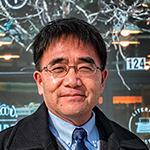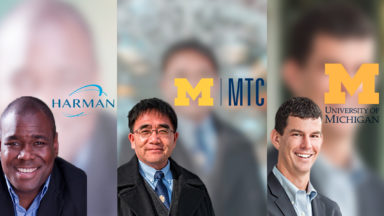Jason Johnson, Director of User Experience Design, HARMAN International; Huei Peng, Director, Michigan Mobility Transformation Center, University of Michigan; and Bryce Pilz, Clinical Assistant Professor of Law Entrepreneurship Clinic, University of Michigan, talk about the advances and restraints of autonomous vehicle technology, the changing dynamics between OEMs and suppliers, and the legality tied to this technology. The panel is moderated by Phil Santer, VP of Business Development, Ann Arbor SPARK.
Some of our key takeaways from the conversation:
- Building Trust in Future Tech:
For autonomous technology to go forward, it is imperative to build a robust software to support it. Software developers need to understand that fixing bugs is not enough, rather understanding the needs of the user and providing seamless over-the-air updates to improve the in-vehicle technology today will help build confidence and trust in future technologies. - Technology is Changing Relationships:
With technology in the automotive industry evolving at warp speed, the relationship between OEMs and their suppliers and research organizations has evolved to be a symbiotic one. The partnership between research institutes, like the MTC, and the companies helped collect large amounts of data to hasten the development of the industry. Supplier-OEMs have emerged in partners working hand-in-hand to develop superior technology and reduce liability. - Fast-moving Technologies Need Friendly Laws, Quickly:
Legal issues have been the greatest deterrent to the development of autonomous vehicle technology. Determining who exactly should be making the law, what is the right law, the uniformity of the laws across different states, and who is liable if anything goes wrong while ensuring that the business model of the companies developing these technologies are some the biggest troubles lawmakers are facing today.
Below are some of the key points and moments from the conversation:
- 1:38 – HARMAN creates technology enablers and cloud-based solutions for autonomous vehicles
- 6:13 – OEMs need to partner with software development and engineering firms to provide technology enablers for autonomous vehicles
- 9:23 – University of Michigan Mobility Transformation Center’s MCity is one of the largest living laboratories that focuses on connected and autonomous technology and is working with Michigan’s DoT to expand its premises
- 16:19 – MTC has 17 leadership companies and 45 affiliate members; it has also collaborated with companies like PreScan and Ford to collect large quantity data to develop automated vehicles
- 21:15 – Stringent and varied laws and provisions across the country are the biggest hurdles to developing and deploying autonomous vehicles
- 31:31 – NHTSA tries to keep pace with the development of autonomous vehicle technology and plans to come up with model state policies to ensure a level of uniformity in the rules across the nation
- 33:28 – Q&A – What are the ways in which technology providers can waive off liability?
- 34:20 – Q&A – Is there a way in which autonomous vehicles can be protected from cyber threats?
- 36:16 – Q&A – Is there a need to increase the number of technology centers and accelerator centers to boost innovation at Detroit?
- 37:44 – Q&A – What are the elements that would drive Detroit forward?
- 38:52 – Q&A – What is the take about after sales and retrofitting in autonomous vehicles?
- 41:12 – Q&A – Is the MTC testing any unmanned aerial vehicles?
- 42:32 – Q&A – Is there any harmonization between the regulatory frameworks in different states?
- 44:25 – Q&A – What is important to prevent brain drain in the region?












